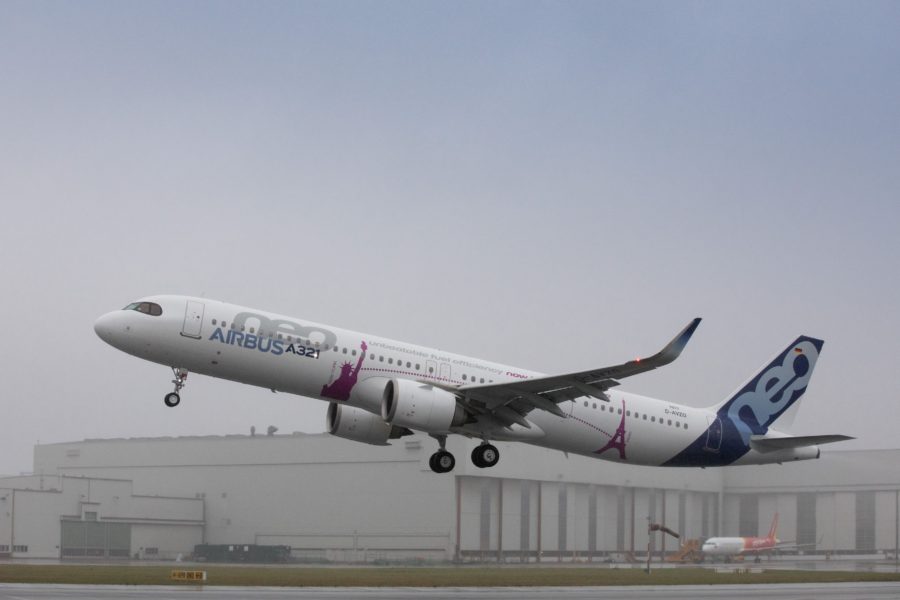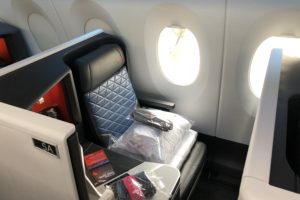The New Transatlantic Jet You Haven’t Heard Of – Everything You Need To Know About The Airbus A321LR
Featured Image: The Airbus A321LRs maiden flight (Image Courtesy Of Airbus).
The Airbus A321LR (long range) may very well be the replacement for the aging Boeing 757-200 on its longer routes. The aircraft has a range of 4000 nautical miles, which is even more than the Boeing 757-200s (which was about its size). You very well might be finding yourself on this aircraft on transatlantic flights this year — and perhaps even with a US airline within the next few years. But what makes this aircraft so special and important?
The 757’s Retirement And The Need For A New Aircraft
The Boeing 757-200 was introduced in 1982 and was taken out of production in 2004. It has a range of around 3,900 nautical miles which can easily fly on shorter transatlantic routes. It can hold approximately 180-200 people in a two-class configuration. It was originally and still is popular for high yield short-haul routes around the world which have a higher capacity than the Boeing 737 or 727 could support.

However, over time, it also became increasingly popular among US airlines such as American, Delta, United, and back in the day US Airways for being flown on longer routes which pushed its range limits. It is now very popular among those airlines for shorter transatlantic or long-haul routes which don’t need the capacity of a 787 or even 767 such as from Washington to Edinburgh, New York to Porto, Reykjavik to Denver, or Newark to Lima. The list of such routes that are around 2500-3800 nautical mile routes goes on and on.
Later on, the 757-300 was introduced, but it has a shorter range, is a stretched version of the -200, and wasn’t that successful. Now, the 757 is approaching its 40th birthday in a few years. The plane is old and most 757s of airlines are pretty worn on the interior. However, the need for a plane of the size and range of the 757-200 still exists. But there hasn’t been any plane introduced that’s has the same size and range of the 757 – until now.
Airbus Introduces A Replacement – The A321LR
Now, the majority of 757-200s that were in operation have long-since been retired. However, American still has 34 of the 757-200, United has 56 of them and Delta has over 100 of them. They all have plans to retire them over the next years. Airbus saw a large market opening with the 757’s demise and decided to introduce an aircraft with similar capacity and range: the Airbus A321LR, which is based on the Airbus A321neo. Airbus announced that they would create a version of the A321neo which could fly a longer range than the regular version, introduced in 2014. There now is an increasingly large market for low-yield long-haul routes between smaller cities, so this aircraft is coming into service at just about the right time.
There will be so many new routes that haven’t ever been economically sustainable ever before which now will be able to commence. The A321LR is extremely fuel efficient, which will save fuel costs compared to the 757, making it, even more, cost-effective. The plane will be able to economically connect many more city pairs than now due to the low yield of many such routes.

What You Need To Know About The A321LR
- The aircraft is able to carry up to 240 people in a 1 class configuration, but will usually seat about 170-200 passengers in a two-class configuration.
- As stated earlier, it will be able to travel up to 4,000 nautical miles as opposed to the Boeing 757-200s 3,900 nautical miles. For reference, the A321LR will be able to fly on the following routes (which the aircraft might realistically fly on)
- – New York to Rome – 3,700 Nautical Miles
– Washington DC to Berlin – 3,650 Nautical Miles
– Minneapolis to Honolulu – 3,400 Nautical Miles
– Sydney to Phnom Phen – 3,800 Nautical Miles
– Sao Paulo to the Azores – 3,900 Nautical Miles
– St. Louis to London – 3,700 Nautical Miles - The reason why the A321LR has a much longer range is that it has more fuel tanks than the A321neo. Most of the other technical specifications are nearly identical to a regular A321neo – the only thing that makes the plane special is its long range.
- The Aircraft looks slightly different than normal Airbus A321LRs. It has the Airbus A321 cabin flex layout which means that the aircraft has two doors in the front, two in the back, two or four overwing exits, and two exit doors behind the wing. That results in a total of 8-10 exit doors.
- Arkia took delivery of their first A321LR in November 2018 and became the first operator of the aircraft. Primera Air was supposed to be the launch customer of the type, but it went bankrupt in October.
- This should be obvious for most of you, but the economy class cabin is in a 3-3 configuration and most premium cabin configurations would be 2-2.
What Airlines Have (Or Will) Order The Airbus A321LR And Where Will They Fly Them?
First off, Arkia was the launch customer of the aircraft (as I mentioned earlier) and currently flies them between Tel Aviv and Barcelona, Bucharest, Sofia, and Eilat. They only ordered three of them, so they won’t be the largest operators of the aircraft by far! For North Americans, the two most exciting airlines that have firm orders on them are Aer Lingus and TAP Portugal. Ireland’s Aer Lingus (ordered 14 of them) will use them to replace their 757s and will initially fly them from Dublin to Minneapolis and Montreal and might also fly them around Europe. TAP Portugal (also ordered 14 of them) will initially fly their A321LRs from Lisbon to Tel Aviv and from Porto to Newark. Both airlines will have lie-flat seats in business class in an alternating 1-1 and 2-2 configuration and will both take delivery of their first aircraft this year.
Norwegian Air Shuttle ordered 30 of such aircraft and intends to take delivery of their first ones this year. They will fly them to lower yield destinations in North America from cities in Europe such as Dublin or Edinburgh. However, they are in financial trouble so the deliveries might be delayed. Canada’s low-cost carrier Air Transat plans to take delivery of 15 of them which it will use to replace its dated A310s on its transatlantic routes. Azores Airlines will take delivery of four of them which it will hopefully use to expand in North America and mainland Europe.

In Asia, Air Astana intends to take delivery of four A321LRs which it will use to expand its long-haul route network to Europe and East Asia. Australia’s low-cost Jetstar Airways will take delivery of an unannounced number of them which it will use to fly from Australia to smaller destinations in southeast Asia. Japan’s Peach and the UAE’s Air Arabia have both also placed orders for A321LRs. Qatar Airways also just a few days ago placed an order for 10 A321LRs which it will likely fly to smaller cities in Europe, Africa, and East Asia.
In the US, JetBlue has shown much interest in the A321LR. They have been wanting to expand to Europe for some time now, although their aircraft couldn’t have done so previously. They would then fly the aircraft from New York and Boston to larger cities in Europe such as London or Dublin. What makes JetBlue think that they could be successful transatlantically is that they consistently offer low fares in their fantastic business class Mint product and in economy class. I would be highly surprised if a subset of American, Delta, or United didn’t eventually place an order for the A321LR to replace their aging 757-200s, although they all haven’t made any official comments.
An Even Longer Range?
Airbus for some time now has been thinking about creating a version of the A321LR which can fly even further – the A321XLR (extra-long-range). It’s now almost confirmed that Airbus is developing the aircraft due to multiple hints by the company. If it is introduced, it would be able to have a range of around 5000 nautical miles, more than any commercial narrowbody jet has ever had.
My first thought is that most people probably wouldn’t’ want to be in a narrowbody jet for that long, as it can get claustrophobic for many people to spend up to 9 or 10 hours on such a small plane! However, if introduced, it could potentially introduce many more new routes than the A321LR could and could go for many transpacific and very long transatlantic routes. It would potentially then compete with the Boeing 797 in terms of size and range which will be introduced this year at the Paris Air Show this summer.
Conclusion:
The Airbus A321LR is an exciting new aircraft that will be introduced by many airlines this year. It is viewed as Airbus’ attempt to directly replace the Boeing 757-200 which many airlines have been using on long-haul routes with a range of 4000 nautical miles. It will be in service on transatlantic flights with TAP Portugal and Aer Lingus this year and likely will be operating on US airlines such as JetBlue, Delta, and United within the next years. The aircraft hopefully will bring about many more currently-nonexistent long-haul flights between secondary cities!
What do you think of the Airbus A321LR?




